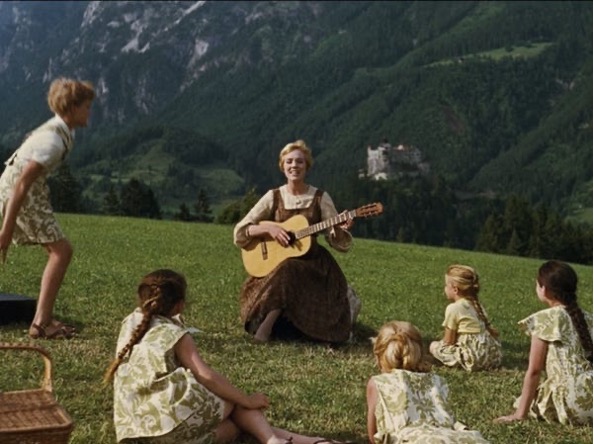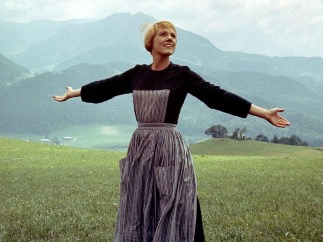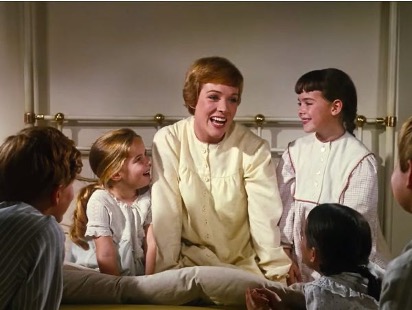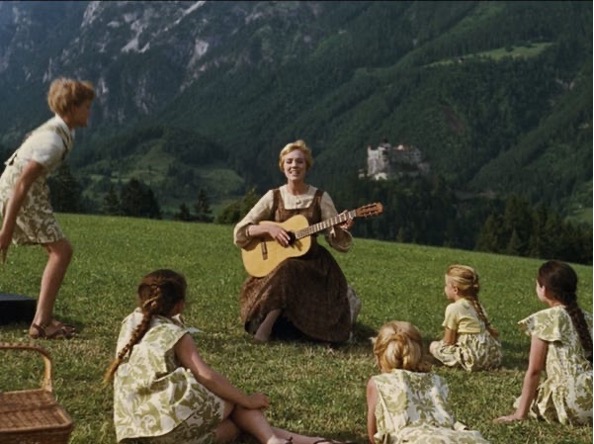
Do you remember this scene from the movie The Sound of Music? Fraulein Maria is entertaining the seven von Trapp children on a mountain meadow. I confess to being totally taken in by this movie. It is utterly charming. The beauty of spirit and attitude seen in Maria (Julie Andrews) is grand. We all want to believe there really are people in life like Fraulein Maria. Yes, she and the children and Christopher Plummer–Captain von Trapp, the widower with seven children–had all just come from make-up and their hair stylist immediately before shooting a given scene, but still there was a beauty and charm that emphasizes the positive and refreshes the viewer. It is life like we would want it to be. Ideal. Warm. Kind. The Sound of Music is delightful!
But behind the beauty of heart and attitude, there was an enormous amount of work.
A young Julie took once-a-week voice lessons from a woman named Madame. This was in Leeds, England in the 1940s. Madame played the piano badly, her hands bejeweled with rings and long, pretty fingernails, clacked on the ivory keys.
In her book Home; A Memoir of My Early Years, Julie wrote that Madame’s accompaniment was mostly only “suggested,” and that she–Julie–filled in the blanks in her head as she was singing, “but it did not matter because she was a superb and loving teacher” (p. 94).
Madame would sit at the piano, Julie beside her on the bench, and they would work a long time on technique. Lessons started with breathing exercises and then gentle scales. For example, the five-nine-thirteen scale, was notes of any scale sung in chromatic sequence up and back again, first five, then nine, then all thirteen of a full octave. She would sing these scales using assorted vowels, usually a strong “B,” the “Buh” pulling the voice forward, followed by a long E. These exercises strengthened her voice, placing it behind the teeth and forward of the throat so that she did no swallow the sound.
Madame said, “Think of a string of pearls, each pearl identical to the next. I want you to bring the high notes down to where you place your low notes and bring the low notes up. As you come down, bring the voice up and as you go up, bring it down” (p. 95).
Julie’s mother was a disciplinarian who insisted that Julie practice each day. Both her parents were musical entertainers, so when they were on the road, sometimes Julie had to practice on an empty stage as stage-hands and assorted others moved about the theater. Being listened to was uncomfortable for her.
By the time she was 12, she was singing operatic coloratura arias.
She practiced Handel a great deal, using just the exercise vowels at first, then progressing to the words of songs like “I Know That My Redeemer Liveth.” Madame said, “When in doubt, return to Handel.” And Julie added, “Handel will never let you down vocally.”
Julie wrote, “Madame put great emphasis on the ends of phrases. She would say, ‘Follow it, follow it, follow it–see it going down the road in front of you far as you can see. See it disappear into the distance. Then just close your mouth on it and finish the sound.’”
Many voices have a natural break going from mid-voice into the higher register. Julie called it “gear shifting.” Madame was firm, “No gear shifting allowed.” She insisted that her students would move up or down in a smooth line and without a change in tone [the visual equivalent would be a lineless bi-focal]. Julie adds, “She did not let me use any chest voice at first, which was extremely good training for me as a youngster” (p. 97).
Madame wanted Julie to follow her into the opera, but Julie concluded that she did not have the necessary guts and weight for opera [I assume Julie was meaning she was not a 300-pound soprano].
“I tried and tried to find what Madame called ‘that special place,’ but never achieved it (page 98). My attempts usually resulted in a somewhat pinched, nasal sound . . . by the time we had worked together for fifteen years, I knew enough what was correct and what wasn’t, though one never stops learning, feeling, making vocal choices. Continued maintenance and ‘refresher courses’ are essential” (p. 99).
According to Julie, learning to become a singer is “all about sensing, listening, making subtle adjustments, finding out why something doesn’t work and solving the problem.” Occasionally, Madame would make Julie articulate a word like beautiful, for example. “But time and again she drilled into me that if I was true to my consonants–then the consonants would pull my voice forward and keep my vowels true” (p. 100).
Right from the start, Julie was expected to practice daily. She had to really knuckle down (her sentence). “My exercises were practiced alone, but my mother often worked with me on specific songs afterwards.”
Certain songs Julie simply could not sing–songs in the minor key or with a yearning reference. She was overwhelmed by the sadness of Puccini’s lyrics. She would feel her throat closing as she choked up. Sliding more behind her mother than beside her, Julie would fight tears for all she was worth. But suddenly the voice would be gone in a mess of emotion. “Mum would turn about and see me simply bawling my eyes out. ‘Oh, Julia, don’t be so stupid.’”
“Sometimes there were tears of fatigue, tears of frustration or rage with herself when she could not get something right” (p. 101).

Madame accepted Julie’s emotional temperament, saying she should not be embarrassed to be moved by the music. “It shows that you are a sensitive human being, capable of much feeling.” Which was why madame would not let her sing much Puccini. Or the great arias from Madame Butterfly or La Boheme. “No, you will sing them when you’re older and your voice is more mature. Right now it would just pull you to pieces vocally. It is too emotional; too beautiful and sad, and you will be caught up in it and damage the instrument” (p. 102).
As Julie was about to take her Grade V exam she said, something magical happened. “I remember standing in the corridor at school and feeling weary—awaiting my turn with the examiner. I could hear the piano playing music for the student ahead of me. I was nervous, I felt unready, and even wondered if I would hold up because of fatigue. My body seldom felt as strong as I needed to be. All the other girls seemed so enthusiastic and capable.”
My name was called and I hesitantly went into the room. Sunlight was shafting through a big window and the studio was filled with light.
“Come forward, dear,” The examiner said pleasantly. “Let me meet you and say hello.” Of this moment, Julie said, “She put me at ease as she asked me to show her my barre work. The pianist played my music in the background. Suddenly, surprisingly, I was inspired. My body felt supported, my arms extended and became graceful. My legs worked and energy came at the right time. I was able to let go and dance with freedom and pleasure” (Page 103).

A fine musician works until he/she has perfected a piece. But a professional practices until the music is second nature and failure is impossible, which explains how Julie Andrews could sing before large crowds as a 12-year-old. She worked, worked, and worked some more.
The point of this article is to provide a glimpse of the years of work that went into Julie Andrews sitting in the meadow (please look again at the picture at the start of this article), singing the Do-Re-Me song, jumping from middle C to E and back to G.
Very, very few will achieve the stardom Julie Andrews achieved. It is very possible to work, work, work and never get the recognition she received.
But all of us can be alive to God (see article Alive to God) in a way that brings positive attention to God and grand fulfillment, peace and contentment to us.


Recent Comments